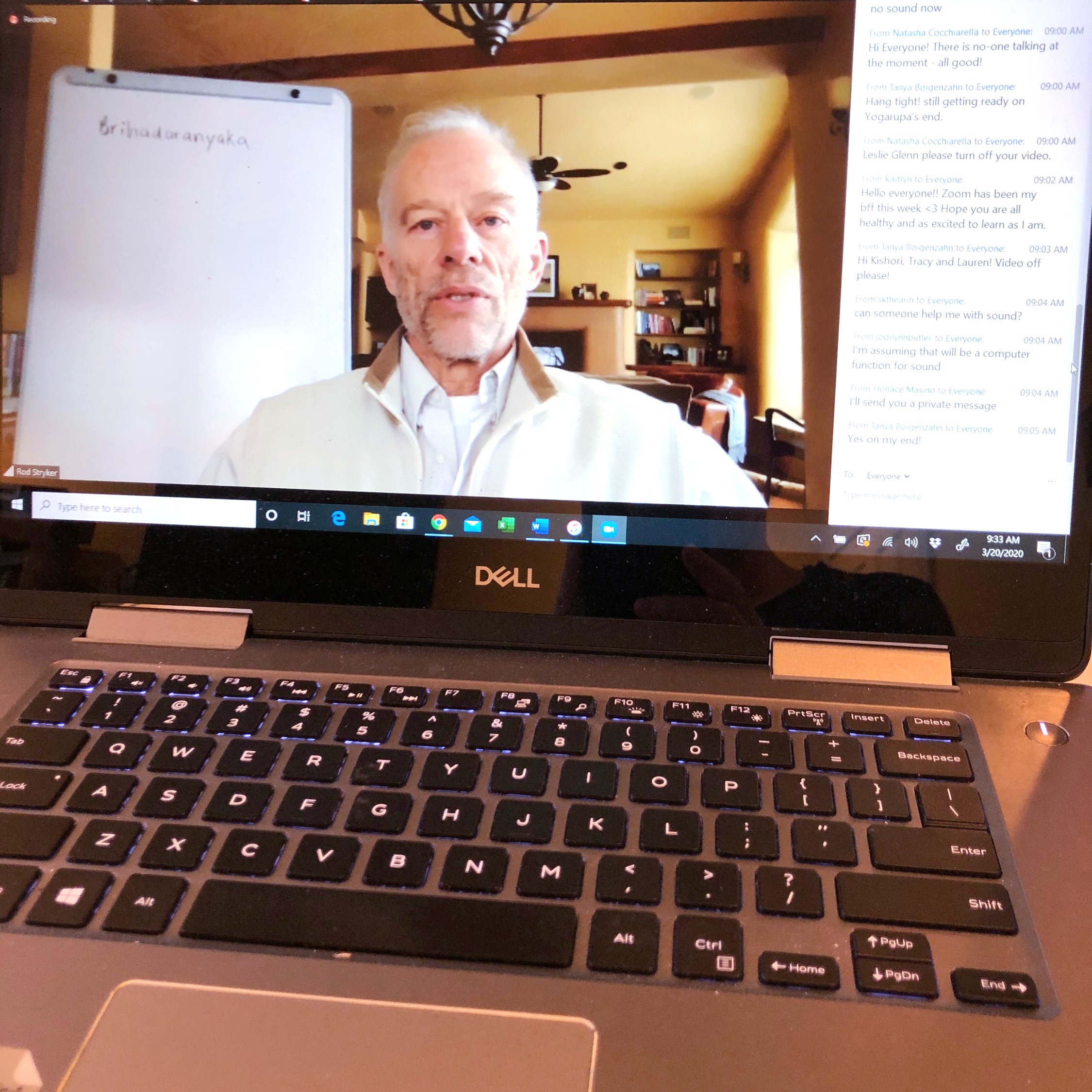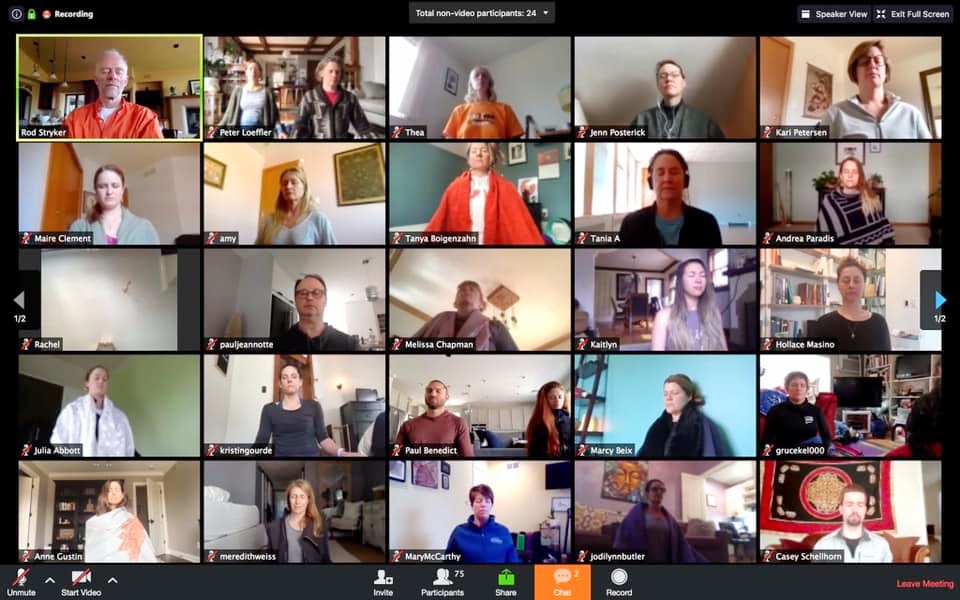During times of loss, unpredictability, scarcity and pain we are not our best selves. We are in survival mode and doing our best to manage our circumstances. We have all entered this time. The coronavirus pandemic has affected us all. No one has escaped.
Last weekend (March 20-22, 2020) I attended an online yoga workshop via Zoom hosted by Devanandi Yoga in Minneapolis, MN and taught by Yogarupa, also known as Rod Stryker because of the coronavirus pandemic and social distancing. It was pretty incredible experiencing how quickly we transitioned from an in-person weekend workshop to an online setting including lecture, breakout sessions, and yoga practices.
The workshop was titled “Uncovering the Secrets of the Brhadaranyaka Upanishad: A Parayoga Immersion Weekend.”
I have been looking forward to attending this workshop for the past five years. When the Anusara tradition fell apart in 2014, I started searching for a new tradition and teacher. My training was deep with alignment-based teachers and I knew I wanted something different. During my 500 yoga teacher training with Carole Westerman in Omaha, NE I was introduced to a variety of teachers. My understanding of traditions and teachers grew and I was on a quest to find a teacher I resonated with and wanted to learn from.
Today I consider my primary teachers to be Yogarupa and Elena Brower. Elena was also trained in Anusara and Yogarupa is one of her teachers. Yogarupa embodies the entire practice of yoga with asana, meditation, pranayama, contemplation, and follows the Tantra tradition. “Tantra (a Sanskrit word) is a compound of two verbs, tan and tra. The verb tan has two sets of meanings. The first is “to expand, to grow, to expound, to give meaning.” Tan also means “to weave, to intertwine, to integrate, to connect, to breathe newness into the old, to pull the present out of the past and give it a meaningful future.” The second verb in this compound, tra, means “to protect, to free from sorrow, to help one move away from the domain of afflictions.” Thus tantra refers to the path of health and healing, science and spirituality, that holds our full expansion and development as its main objective. It shows us how we can grow and blossom. It shows us how to find purpose in life and how to weave the tapestry of life in the most meaningful manner, how to protect and nurture ourselves, and how to protect and nurture others.
According to tantra, the world is beautiful. Life in the world is beautiful. Our inability to see the beauty within and without is bondage for it forces us to live in this world purposelessly. The quest for freedom here and now begins with understanding the sacred nature of our body, mind, and senses. According to tantra, the body is the living temple of divinity. The center of consciousness (soul, atman, jiva) is the highest divinity within us. The power and potential of the soul that is awakened and active in us is called prana. Prana, the force that keeps us alive, is the intrinsic and vibrant attribute of this inner divinity.” The teachings and practices in the Tantra tradition help us connect to our prana and create right relationship with our Highest Self (with a capital S).
Now back to my weekend workshop experience…
One week prior to our weekend together in Minneapolis, I received an email letting me know the workshop will continue to be held but it will be lead virtually via Zoom instead of in-person. I was disappointed. I have been practicing online with Rod on Glo, Yoga International, and with his Sanctuary App. I was really looking forward to being in his presence and feeling the energy of the Parayoga Sangha. However, instead of being cancelled, I was also grateful to have the experience and understand the teachings and practices can be guided and taught online. Luckily I was still able to participate in the entire weekend safely in my home. My home office is filled with healing energy and light and my husband was home to help take care of our kids so I could retreat to practice and learn.

The Upanishads guided our teachings over the weekend. Rod shared with us how challenging it can be to teach the Brihadarayanaka Upanishad because of the non-dual teachings. However, at the end of the weekend, my heart was full and I have a deeper understanding of these ancient teachings.
Swami Rama helps us understand where these teachings come from. The following information is taken from an article published in Yoga International. “The Vedas are the most ancient scriptures in the library of man. The eternal laws of life and the universe expressed in these scriptures were revealed to seers and sages who devoted their entire lives to the realization of ultimate truth. These seers received this knowledge not through sense perception or the mind, but through inner vision directly from the source of intuition during the deepest states of contemplation and meditation. The finest section of the Vedas is comprised of the Upanishadic literature, which is generally known as Vedanta. Upanishad means “that which destroys the ignorance of the individual soul; that which guides the seeker toward the attainment of the highest wisdom; that which loosens our attachment to the material world and to the perishable self.” The Upanishads are said to be the epitome of Vedic knowledge and the treasure of the innermost experiences of the Vedic sages.”
Throughout the weekend, we gathered online as a community practicing meditation, asana and pranayama. We were asked to contemplate on a couple of main themes. The first topic to consider was how we as yoga teachers are transactional or relational. Do we seek teachers whom we can have a relationship with or are we merely looking for information we can turn into a commodity? If we are looking to turn around and share the information without embodying the teachings then this is transactional. I give you something and you give me something in return. We were all invited to reflect on how we are in relationship with our students and others in our lives. Teachings become more superficial if it does not include relationship. As I reflected on these statements, I started to understand why I was seeking a teacher I could have a relationship with. As a student, I want to have a teacher who can guide me into the deeper teachings and wants to be in relationship with me. As a teacher, I find the most value with students who practice with me over time and want to create a deep relationship to their practice and the teachings.
Another concept we contemplated and reflected on was our relationship with fear.
We experienced a very profound meditation giving it a name and form (Namarupa). This “it” was fear. And it is very relevant for these times because so many of us are experiencing fear, especially of the unknown. In the meditation we were asked to name fear and then feel where it is contracting or feels tight in our body. For me it was in my belly and my throat. My abdomen felt tight and I had the urge to scream. Once we felt the fear in our body we were asked to reflect on the stories in our minds and draw upon our memories. These were our samskaras. Pandit Rajmani Tigunait shared with us in another Yoga International article, “Samskaras are the subtle impressions of our past actions. Each time the action is repeated, the impression becomes stronger. This is how a habit is formed. The stronger the habit, the less mastery we have over our mind when we try to execute an action that is contrary to our habit patterns. Good deeds create positive samskaras, bad deeds create negative ones. In the long journey of life, we have performed all kinds of actions—right and wrong, good and bad. Our mind is a warehouse of positive and negative samskaras, and it is up to us whether or not we exercise our willpower and determination to strengthen or eliminate a particular group of them.”
Rod asked us to reflect on our memories with fear and times in our lives when we felt fear. We were not asked to change it, but to remember, feel and gain insight into why we may be feeling this way. This give us a better understanding of our samskaras. During the last part of the meditation, we were asked us to reflect on Karma at the level of doing, speaking and thinking. What can we now do in action to help us move forward into understanding and healing. Once the meditation was over, we were reminded that all fear is born of separateness. It is the knowing of “I am” that heals us.
The last major theme we discussed is where we place our focus or attention. Is it on the objective, subjective or Higher Self? When we are “object” focused we are validated by others and receive knowledge from the outside world. When we are “subject” focused we are absorbed in our own thoughts and the stories we replay in our mind. When we are connected to Self we are reminded that our higher self cannot be seen, it is what allows us to see. It is not recommended we never listen to the news or reflect on what our inner dialogue is telling us. But when we are connected to our “Higher Self”, we are not separate and can we can rest in the deep knowing of “I am.”
Homework from this discussion was a reflection on our discord with what we believe our dharma is and how it is expressed in our actions, words and thoughts. We were invited to meditate on each of these three areas in our lives and gain a better understanding of the causes of our suffering. Joy is deepened and suffering is diminished when we are in right relationship with our best and Highest Self.
A beautiful mantra we chanted during asana and in meditation was “OM Jyotir Atma.” OM is opening to the absolute. Jyotir is light and Atma is soul. OM Jyotir Atma. “I am light of the Self.”
The weekend ended with encouragement to commit to a personal practice that is always available and accessible and to be in right relationship with our Self. It is helpful if our practice is consistent, expressed with ritual, qualitative and anchored in prana (life force).
My commitment to myself and my practice includes waking up an hour before everyone else in my home so I can meditate, practice asana and pranayama, journal my feelings and read articles or books that deepen my knowledge and understanding of the practice of yoga. I know I need my practice now more than ever during this pandemic outbreak. When I am anchored I can be a calm and steady force for my family and those I am in relationship with.
May we all take refuge in the space that is available to us all. This deep sense of peace within our souls. It is the turning inward that sets a yogi apart.
Thank you Yogarupa for your teachings and the Devanandi staff for making these teachings available during these unprecedented times. Namaste’


